Weaving a life around looms
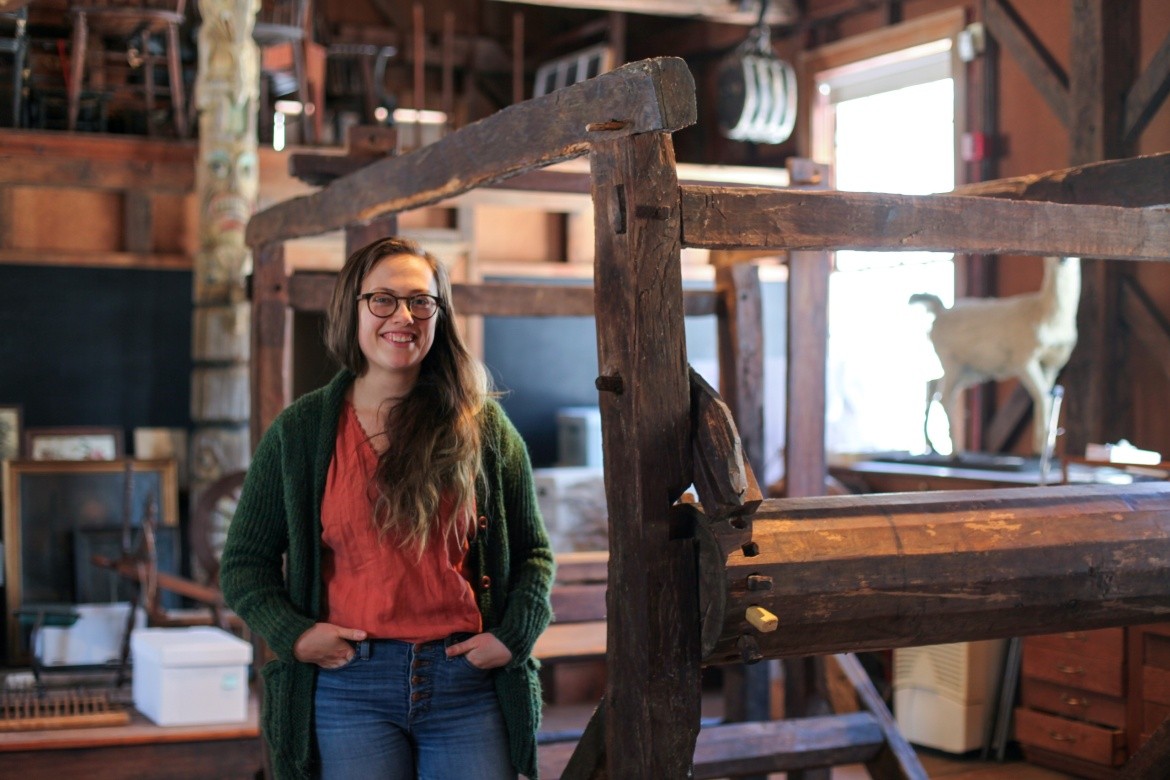
Erin Hancock ’20’s lifelong interest in weaving and folk arts came together when she found a 200-year-old loom in Mount Holyoke College’s Skinner Museum.
Anthropology major Erin Hancock ’20 was working at the Joseph Allen Skinner Museum in January 2019 when her supervisor, Aaron Miller, suggested she explore a storage shed next door. Specifically, a pile of loom parts housed within.
Miller, associate curator of visual and material culture at the Mount Holyoke College Art Museum, was skeptical that the parts formed a complete loom — or that what was there was salvageable. But he knew Hancock had been impressed by another historic loom, which is fully constructed and on display in the Skinner Museum.
Hancock jumped at the chance. And her efforts paid off. She discovered the pieces of a 200-year-old loom that she was able to clean up and put together, all with the support of Miller and other Mount Holyoke faculty and staff.
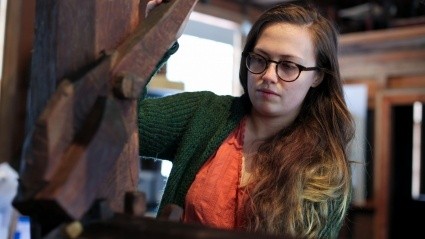
“Erin has an insatiable appetite for textile learning of all kinds but especially a deep, lifelong connection with weaving,” Miller said. “I’m lucky that my job intersects with people like her — students and faculty who see the value of engaging with material culture. The varied campus collections at Mount Holyoke and the access that our community has to these resources are an extraordinary opportunity for our students.”
She is grateful for the unique opportunities and support offered by the College, said Hancock, who was working as an Almara History in Museums intern at the time. “Mount Holyoke and the Art Museum staff gave me an incredible learning experience. I couldn’t have done this project anywhere else.”
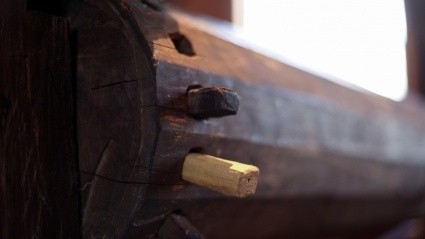
“Do you want to get this loom up and running?”
The building where the loom parts had been stashed was crammed with materials and didn’t have heat or electricity. So Hancock put on her jacket and used the flashlight on her iPhone. At first, she thought she was just looking at some old lumber. But then in the gloomy semi-darkness, the structure started to emerge in her mind.
“I hadn't worked with any barn-frame looms, but I had done enough research to recognize the bits and pieces,” she said. The loom gets its name because it is put together with mortise and tenon, one of the joinery types used in post-and-beam barn framing. As she sorted through the heavy pieces, she thought, “Whoa, it looks like we have actually like 85 percent of this loom!”
In fact, she found about 10 major pieces of the loom, along with a number of smaller parts, including some pegs and a weight that helps with the mechanism.
“Do you want to take it out of here and put it together?” Miller asked Hancock. “Do you actually want to get this up and running?”
The answer: Absolutely.
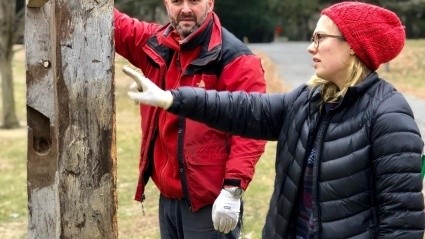
A 200-year-old Ikea kit
Hancock has wanted to work with barn-frame looms since she first learned what they were at age 10. She has studied traditional weaving with the Quechua and Aymara women in Bolivia and Peru and spinning from Norman Kennedy, a National Heritage Fellow and the founder of the internationally known Marshfield School of Weaving — all before she came to Mount Holyoke. (Please see sidebar following the story for more about Hancock's pre-college training.)
All that preparation came together now. First, she, Miller and Jackie Finnegan ’08, the museum preparator at the Mount Holyoke College Art Museum, moved the pieces outside and put them together. Its creator had made its reconstruction easier by carving roman numerals into the pieces that slotted together, like a 200-year-old Ikea kit.
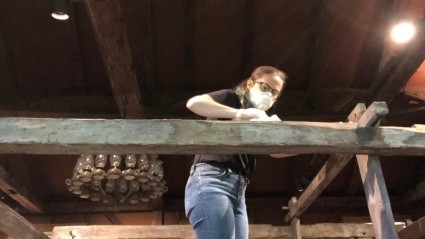
The loom also needed a good cleaning. Hancock used a broom and then a shop vac to clean off the nearly 100 years of detritus. As she cleaned, the loom’s story revealed itself.
“The treadles were hand-hewn with a hatchet. You can see the rough hack marks,” Hancock said. “It has those square, handmade nail heads. We think it’s late 17th- to early 18th-century. It’s still in pretty good shape. It’s a little funky, a little lopsided. So maybe this was someone’s first loom, a training loom. It probably was used by weavers of multiple skill levels throughout its history.”
An 18-month project — at least
Hancock continued to work on the loom that spring. She also did an independent study with Lan Wu, assistant professor of history, researching barn-frame looms, cultural history, women’s history and material objects, and otherwise educating herself on the appropriate methods and techniques to recreate and operate the loom.
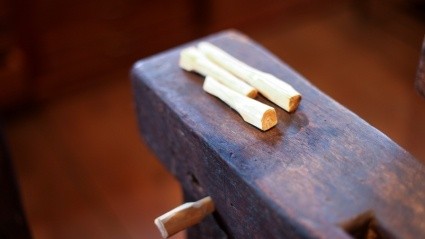
As a Lynk-funded curatorial intern at the Art Museum that summer, Hancock worked with Kris Camp, design mentor and technical lead in the Fimbel Maker & Innovation Lab, to begin to recreate the loom’s missing parts, which included pegs, heddles and treadles.
“I hand-carved a fair number of parts,” she said. “I sat outside and used my pocket knife at first, and then I borrowed a tool from the Fimbel Lab. People found me pine branches and sticks to use. I’d see if it would fit and then carve a little bit more, to actually make it fit.”
Now Hancock is working on a senior thesis that explores looms and weaving culture with Assistant Professor Sabra Thorner, a cultural anthropologist.
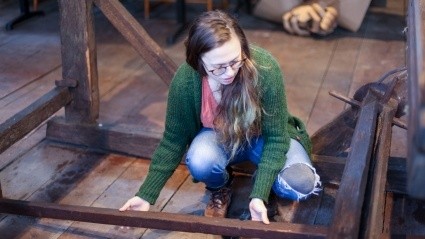
The future looms
Hancock’s barn-frame loom is now at the Schoolhouse, another building next to the Skinner Museum. Her goal is to get it fully operational so she can make some cloth.
“I’m interested in the actual embodied practice, talking about that in relationship to community as well as the music and languages associated with the weaving process,” she said. “Bringing back voices that have been lost. Keeping the whole tradition of music and making it live.”
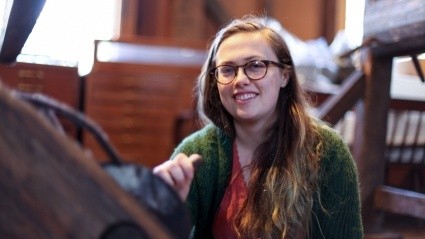
Hancock is applying to graduate programs in Scotland to study Scottish history or ethnomusicology, both in relation to textiles. She’s also exploring grant possibilities to continue to study weaving and do research into making tweed entirely by hand — dying and mixing the wool, spinning it and then weaving it.
She and Miller hope that the loom will become part of the Art Museum’s study collection, which will allow it to be a valuable tool for hands-on learning.
“Close viewing of historical objects can be powerful,” Miller said. “Sitting where others sat, going through the same rhythmic motions of weaving, taking part in traditions of making that span the centuries — that can be truly transformative.”
A life-long love of wool arts
Erin Hancock’s passion for wool arts started when she was 7 years old and her grandmother taught her to crochet. Three years later, a family friend taught her to spin. That’s when her fascination with barn-frame looms began as well.
When she was 12, that family friend let her know about some upcoming weaving classes a couple of hours away from her home in east Texas.
The teacher was Norman Kennedy, who had traveled from his home in Vermont to offer the instruction. Kennedy, a National Heritage Fellow, is the founder of the internationally known Marshfield School of Weaving, which teaches historical textile arts using barn-frame looms.
“Mr. Kennedy is super cool,” Hancock said. “I took two classes with him, spinning and weaving. The next-youngest person was, like, 32 and the rest were in their 60s.”
She continued to explore her love of wool arts. When she was 13, Hancock started spending summers in Santa Fe, New Mexico, working with dozens of artists from 50 countries at the International Folk Art Market. She took a gap year after high school to study traditional weaving with Quechua and Aymara women in Bolivia and Peru.
“I really liked learning about people’s cultures and traditions,” Hancock said. “So anthropology was pretty obvious from an early age.”